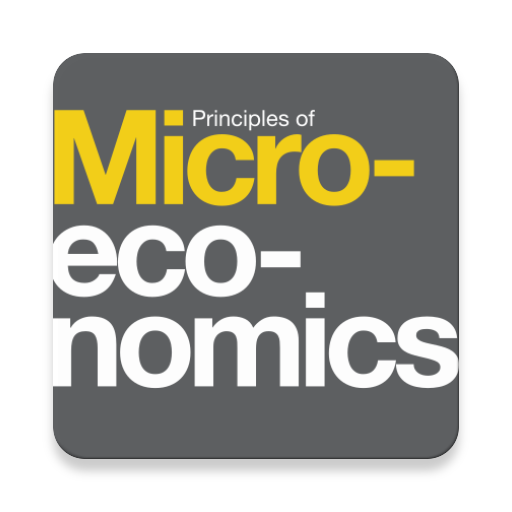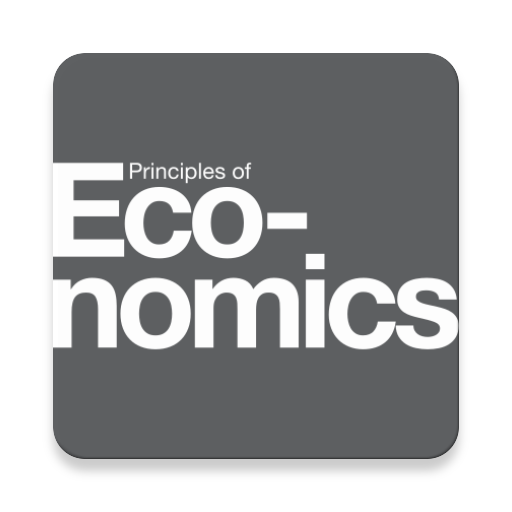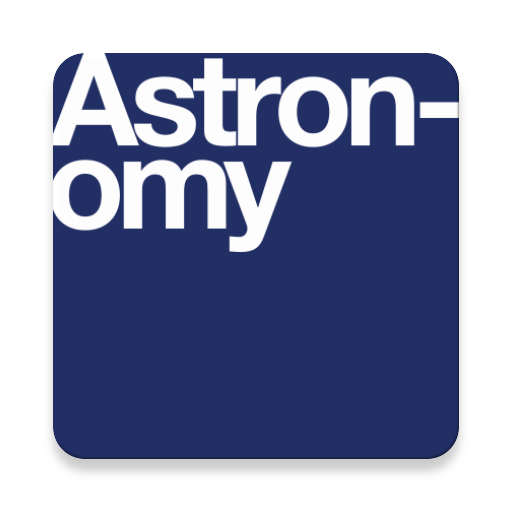

Principles of Microeconomics Textbook, Test Bank
None | QuizOver.com
在電腦上使用BlueStacks –受到5億以上的遊戲玩家所信任的Android遊戲平台。
Play Principles of Microeconomics Textbook, Test Bank on PC
Principles of Microeconomics covers the scope and sequence of most introductory microeconomics courses.
The text includes many current examples, which are handled in a politically equitable way.
The outcome is a balanced approach to the theory and application of economics concepts.
* Complete Textbook by OpenStax
* Multiple Choices Questions (MCQ)
* Essay Questions Flash Cards
* Key-Terms Flash Cards
Powered by QuizOver.com the leading online quiz creator
https://www.quizover.com
1. Welcome to Economics!
1.1. What Economics Is and Why It's Important
1.2. Microeconomics and Macroeconomics
1.3. How Economists Use Theories and Models to Understand Economic Issues
1.4. How Economies Can Be Organized: An Overview of Economic Systems
2. Choice in a World of Scarcity
2.1. How Individuals Make Choices Based on Their Budget Constraint
2.2. The Production Possibilities Frontier and Social Choices
2.3. Confronting Objections to the Economic Approach
3. Demand and Supply
3.1. Demand, Supply, and Equilibrium in Markets for Goods and Services
3.2. Shifts in Demand and Supply for Goods and Services
3.3. Changes in Equilibrium Price and Quantity: The Four-Step Process
3.4. Price Ceilings and Price Floors
3.5. Demand, Supply, and Efficiency
4. Labor and Financial Markets
4.1. Demand and Supply at Work in Labor Markets
4.2. Demand and Supply in Financial Markets
4.3. The Market System as an Efficient Mechanism for Information
5. Elasticity
5.1. Price Elasticity of Demand and Price Elasticity of Supply
5.2. Polar Cases of Elasticity and Constant Elasticity
5.3. Elasticity and Pricing
5.4. Elasticity in Areas Other Than Price
6. Consumer Choices
6.1. Consumption Choices
6.2. How Changes in Income and Prices Affect Consumption Choices
6.3. Labor-Leisure Choices
6.4. Intertemporal Choices in Financial Capital Markets
7. Cost and Industry Structure
7.1. Explicit and Implicit Costs, and Accounting and Economic Profit
7.2. The Structure of Costs in the Short Run
7.3. The Structure of Costs in the Long Run
8. Perfect Competition
8.1. Perfect Competition and Why It Matters
8.2. How Perfectly Competitive Firms Make Output Decisions
8.3. Entry and Exit Decisions in the Long Run
8.4. Efficiency in Perfectly Competitive Markets
9. Monopoly
9.1. How Monopolies Form: Barriers to Entry
9.2. How a Profit-Maximizing Monopoly Chooses Output and Price
10. Monopolistic Competition and Oligopoly
10.1. Monopolistic Competition
10.2. Oligopoly
11. Monopoly and Antitrust Policy
11.1. Corporate Mergers
11.2. Regulating Anticompetitive Behavior
11.3. Regulating Natural Monopolies
11.4. The Great Deregulation Experiment
12. Environmental Protection and Negative Externalities
12.1. The Economics of Pollution
12.2. Command-and-Control Regulation
12.3. Market-Oriented Environmental Tools
12.4. The Benefits and Costs of U.S. Environmental Laws
12.5. International Environmental Issues
12.6. The Tradeoff between Economic Output and Environmental Protection
13. Positive Externalities and Public Goods
13.1. Why the Private Sector Under Invests in Innovation
13.2. How Governments Can Encourage Innovation
13.3. Public Goods
14. Poverty and Economic Inequality
14.1. Drawing the Poverty Line
14.2. The Poverty Trap
14.3. The Safety Net
14.4. Income Inequality: Measurement and Causes
14.5. Government Policies to Reduce Income Inequality
15. Issues in Labor Markets: Unions, Discrimination, Immigration
15.1. Unions
15.2. Employment Discrimination
15.3. Immigration
16. Information, Risk, and Insurance
16.1. The Problem of Imperfect Information and Asymmetric Information
16.2. Insurance and Imperfect Information
17. Financial Markets
17.1. How Businesses Raise Financial Capital
17.2. How Households Supply Financial Capital
17.3. How to Accumulate Personal Wealth
18. Public Economy
19. International Trade
20. Globalization and Protectionism
The text includes many current examples, which are handled in a politically equitable way.
The outcome is a balanced approach to the theory and application of economics concepts.
* Complete Textbook by OpenStax
* Multiple Choices Questions (MCQ)
* Essay Questions Flash Cards
* Key-Terms Flash Cards
Powered by QuizOver.com the leading online quiz creator
https://www.quizover.com
1. Welcome to Economics!
1.1. What Economics Is and Why It's Important
1.2. Microeconomics and Macroeconomics
1.3. How Economists Use Theories and Models to Understand Economic Issues
1.4. How Economies Can Be Organized: An Overview of Economic Systems
2. Choice in a World of Scarcity
2.1. How Individuals Make Choices Based on Their Budget Constraint
2.2. The Production Possibilities Frontier and Social Choices
2.3. Confronting Objections to the Economic Approach
3. Demand and Supply
3.1. Demand, Supply, and Equilibrium in Markets for Goods and Services
3.2. Shifts in Demand and Supply for Goods and Services
3.3. Changes in Equilibrium Price and Quantity: The Four-Step Process
3.4. Price Ceilings and Price Floors
3.5. Demand, Supply, and Efficiency
4. Labor and Financial Markets
4.1. Demand and Supply at Work in Labor Markets
4.2. Demand and Supply in Financial Markets
4.3. The Market System as an Efficient Mechanism for Information
5. Elasticity
5.1. Price Elasticity of Demand and Price Elasticity of Supply
5.2. Polar Cases of Elasticity and Constant Elasticity
5.3. Elasticity and Pricing
5.4. Elasticity in Areas Other Than Price
6. Consumer Choices
6.1. Consumption Choices
6.2. How Changes in Income and Prices Affect Consumption Choices
6.3. Labor-Leisure Choices
6.4. Intertemporal Choices in Financial Capital Markets
7. Cost and Industry Structure
7.1. Explicit and Implicit Costs, and Accounting and Economic Profit
7.2. The Structure of Costs in the Short Run
7.3. The Structure of Costs in the Long Run
8. Perfect Competition
8.1. Perfect Competition and Why It Matters
8.2. How Perfectly Competitive Firms Make Output Decisions
8.3. Entry and Exit Decisions in the Long Run
8.4. Efficiency in Perfectly Competitive Markets
9. Monopoly
9.1. How Monopolies Form: Barriers to Entry
9.2. How a Profit-Maximizing Monopoly Chooses Output and Price
10. Monopolistic Competition and Oligopoly
10.1. Monopolistic Competition
10.2. Oligopoly
11. Monopoly and Antitrust Policy
11.1. Corporate Mergers
11.2. Regulating Anticompetitive Behavior
11.3. Regulating Natural Monopolies
11.4. The Great Deregulation Experiment
12. Environmental Protection and Negative Externalities
12.1. The Economics of Pollution
12.2. Command-and-Control Regulation
12.3. Market-Oriented Environmental Tools
12.4. The Benefits and Costs of U.S. Environmental Laws
12.5. International Environmental Issues
12.6. The Tradeoff between Economic Output and Environmental Protection
13. Positive Externalities and Public Goods
13.1. Why the Private Sector Under Invests in Innovation
13.2. How Governments Can Encourage Innovation
13.3. Public Goods
14. Poverty and Economic Inequality
14.1. Drawing the Poverty Line
14.2. The Poverty Trap
14.3. The Safety Net
14.4. Income Inequality: Measurement and Causes
14.5. Government Policies to Reduce Income Inequality
15. Issues in Labor Markets: Unions, Discrimination, Immigration
15.1. Unions
15.2. Employment Discrimination
15.3. Immigration
16. Information, Risk, and Insurance
16.1. The Problem of Imperfect Information and Asymmetric Information
16.2. Insurance and Imperfect Information
17. Financial Markets
17.1. How Businesses Raise Financial Capital
17.2. How Households Supply Financial Capital
17.3. How to Accumulate Personal Wealth
18. Public Economy
19. International Trade
20. Globalization and Protectionism
在電腦上遊玩Principles of Microeconomics Textbook, Test Bank . 輕易上手.
-
在您的電腦上下載並安裝BlueStacks
-
完成Google登入後即可訪問Play商店,或等你需要訪問Play商店十再登入
-
在右上角的搜索欄中尋找 Principles of Microeconomics Textbook, Test Bank
-
點擊以從搜索結果中安裝 Principles of Microeconomics Textbook, Test Bank
-
完成Google登入(如果您跳過了步驟2),以安裝 Principles of Microeconomics Textbook, Test Bank
-
在首頁畫面中點擊 Principles of Microeconomics Textbook, Test Bank 圖標來啟動遊戲



